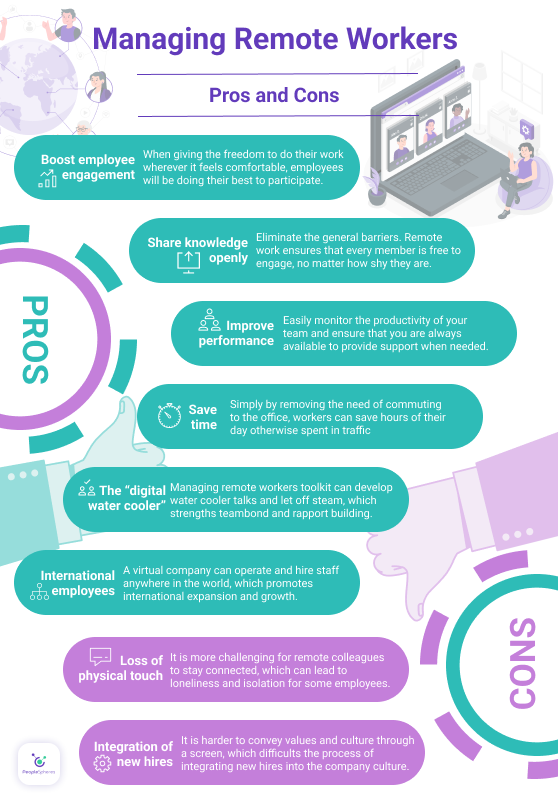-640x380.jpg)
In the last few years, we have seen a total revolution in how we conduct business. People used to physically be present in their workplaces, meetings, and other activities. However, with the dawn of the COVID-19 pandemic, our normal schedules were significantly interrupted. It was impossible to socialize freely like before, social distancing was introduced, and movement was restricted. Some businesses were affected to the point of closing down.
However, some businesses were able to quickly adopt remote working schedules, keeping them in business and clear of their competitors who were still struggling to survive and adapt to the new normal of trends. The culture of working from home gradually started being adopted and accepted in businesses throughout the pandemic. The remote job changed how managers manage their workers who now work remotely, either fully remote or through a flexible work model. The operations within each industry have also been affected by the remote workforce. To help managers adapt to the management of a home-based workforce, we are providing you with the ultimate Managing Remote Workers Toolkit.
Related articles:
Mobile Workforce Management: Why Mobile Employee Experience is Different
5 Ways to Improve Remote Worker Employee Experience
Managing Remote Workers Toolkit
Managers may be used to managing a team physically. However, with the onset of a remote work schedule, this managing remote workers toolkit will help managers sustain the operations for remote workers while maintaining productivity. We will help make things easier for a remote company, especially regarding management and telecommuting.
With the right HR technology, workspaces can now be easily monitored, remote jobs allocated and assessed, and the general work-life improved through management tools. Using Jira templates for tasks simplifies task management with predefined structures, benefiting, for instance, software development teams for coding tasks and bug tracking. Once your remote working team gets down to work, you will need to assign tasks, track their progress, produce their timesheets, produce and manage payrolls, telecommute, and communicate.
As a remote work manager, some tools will come in handy and help you to plan and manage your team. Some of the tools that assists management done remotely include:
- Task management tools
- Time trackers
- Tools to track invoices
- Cloud services
- Collaboration tools
- Workflow management tools
- Project management software
- Freelance service platforms
- Digital assistant
- Tracking software
- Remote assistance software
Managing a Mobile Workforce
With remote work comes the mobile workforce. Today, employees are not bound to one place and many of them get work done while constantly being on the move. A mobile workforce represents employees that are not constrained to a physical location or office space, granting more flexibility. Teleworking workforces can work from anywhere, including from a coffee shop, library, or in an airport while traveling.
A mobile workforce can present new challenges for an HR manager, such as security risk and metrics. Based on a HR tech survey in 2022:
37% of all the companies surveyed (688 industries) had already implemented productivity and performance metrics on remote workers. This is with an additional 35% who are either considering it or are already developing a plan.
PwC
When it comes to security, a trend report in 2022 observed global talent trends and mentioned that:
The convergence of remote working and ever-increasing cyber risk has many executives worried: 96% now see data security as a threat. Two in five are concerned about employees’ lax data security mindset when working from home, putting this on par with their concerns about external breaches.
Mercer
This creates two major points to think about when integrating technologies into your organization.
With employees in a remote location, access can no longer be controlled through keypads and batches. A mobile workforce needs a new type of technology, which you can read all about in our detailed article on mobile workforce management. For secure communication and email usage, implementing standards like DMARC for Gmail accounts is vital. This helps prevent phishing and email spoofing, safeguarding your organization’s data and maintaining trust in remote operations.
Law Poster Requirements for Remote Employees
With the shift to online work, physical postings of state and federal law employment notices are not applicable and it has become more complicated for employers to comply with federal and state notice requirements for a remote workplace. The Wage and Hour Division (WHD) guidelines provided by the U.S. Department of Labor state that electronic notices can supplement physical postings but not replace them entirely. To satisfy the obligations, employers need to adhere to the three following principles:
- Continuous posting
- Individual notices
- Access
Pros and Cons of Managing Remote Workers
Pros:
One might wonder, with all these options, what do I stand to benefit from by adopting management tools? Well, below are some of the advantages of managing your workers remotely.
It boosts the engagement of your team
If there is one thing that comes with remote jobs is flexibility with the freedom to work from anywhere. For example, a work-from-home policy will allow your team to work from the comfort of their home. The team will be good to go as long as they have a good internet connection and the relevant devices (such as laptops, computers, and smartphones). Conferencing and other services have been made easier with people that work-at-home; you can now attend a work meeting from the comfort of your home office.
The fact that you can easily monitor your team, even the ones with a remote position, means that everyone will be available and doing their best to participate. The message you will be sent to your employees is: do your job from wherever you are comfortable. When employees feel comfortable and happy in their job position, remote employee engagement is likely to increase.
Your team can share knowledge openly
A team thrives through communication. It is a critical key in whether a business succeeds or fails. For example, if you have a problem within your production process, you will need views and opinions from your team and co-workers when trying to develop solutions.
Teams and businesses that carry out their operations remotely will need a manager with a good understanding of how to manage remote workers. However, the good thing about working remotely is the fact that honest and open communication is still possible. In fact, it eliminates the general barrier that might be there within a team, ensuring that every member is free to engage, no matter how shy they are.
Improves the overall performance of your team
When managing a team that is working remotely, all you need is to implement some best practices. From here, everything else will be smooth and straightforward. For example, if you have a good communication tool, you will easily monitor the productivity of your remote team and ensure that you are always available to provide support when needed.
A remote employee has to be monitored, but at the same time, it is important to give them enough autonomy to do their job. By being present and utilizing tools like monday.com, you will easily pick out the ones slowing down your productivity and appreciate those with good remote task management skills. Leveraging the expertise of a monday.com consultant can help ensure your team strikes the right balance between oversight and independence.
Saves time
Does remote work save time? Consider this: before you get to work, you have to wake up in the morning, prepare and pack up your things then commute to work. Simply by removing the need of commuting to the office, workers can save hours of their day otherwise spent in traffic. Imagine eliminating all this hassle and instead you can just wake up, switch on your laptop, and get to work.
As a manager, you can assign tasks to your team, send attachments they require, monitor the progress, and give feedback quickly with the right technologies and tools in place.
Establishing a digital water cooler
Water cooler talks are sometimes missed among remote team members. However, a good manager knows the benefits of such activities in a work environment; not everything should revolve around work 100% of the time. Given that water consumption for employees is especially crucial, accounting for almost 34% worldwide in packed beverages, it’s inevitable that water cooler talks will prevail in a physical workplace, reflecting water’s fundamental role in human hydration and health.
A good managing remote workers toolkit can develop these water cooler talks and let off steam. For example, platforms such as Basecamp can allow you to establish channels where such water cooler talks can occur. This goes a long way in strengthening the bond between your team and building rapport. They can even use such channels several times per week, and it will do your business a whole lot of good.
International employees
Remote work opportunities include the recruitment of employees anywhere worldwide. A virtual company can operate anywhere in the world, and with international employees in the workforce, your firm can expand and grow internationally. Being remote takes down location barriers and opens up opportunities to hire top talent and freelancers anywhere around the world.
Cons:
There are additional advantages that come with remote work. However, there are still a few disadvantages too. They include:
The team might lose that physical touch
Even with all the convenience and flexibility, remote working lacks physical interaction. Conversations, presentations, meetings, and even water cooler talks are just not the same when working remotely. It is more challenging for remote colleagues to stay connected, which can lead to loneliness and isolation for some employees.
Later in this Managing Remote Workers toolkit, we will provide a few methodologies to avoid this. Productivity levels can still be maintained at a high level even in a remote environment.
It is difficult to integrate new employees into the company culture
When a new employee joins the team, they are getting acquainted with the company culture and how things are done. While the paperwork and administrative parts of onboarding can be done electronically and automated with software, it is still difficult to convey values and culture through a screen. For this reason, managers of a remote business have to pay extra attention to the communication and development of their team members, especially newcomers.

How Can a Manager Support Remote Employees?
Remote work has its challenges, a fraught of them, actually. However, there are simple ways to improve the remote worker employee experience. Some of these include:
Daily Check-Ins
For example, you can establish a daily call policy at the beginning of a workday for every team member. You can use the video calls to discuss plans, assign tasks, and answer any questions. You can hold one-to-one talks or make it easier for you by using team calls for employees working together.
There are numerous tools you can use to facilitate your check-ins. Whatever choice you go with, ensure that it is user-friendly and everyone on the team is comfortable with it.
Use of Different Technologies for Communications
As a manager, you do not have to limit your interactions with your employees working from home to emails alone. They are not only insufficient, but they can also become cliché. Good managers look for better modes of communication, no matter how remote the workforce is. For example, you can decide to integrate video conferencing or video chat into your communication system. This will give your team members the ability to use none verbal cues and other benefits when communicating.
Establish Clear Objectives
One of the things that highly productive remote teams have in common is a set of expectations and goals that have to be achieved within a certain period. As a manager, you should see to it that every person in your team, including the ones that work outside the office, knows what they should do and when they should do it. With the aid of online solutions, you can easily monitor the progress of employees that are working at home and make corrections where necessary.
Establish Rules of Engagement
Additionally, you can set some rules governing how you communicate with your team. For instance, you can agree that you will use zoom calls for meetings while IM is used in case of any emergencies. This way, you will be ready to deal with everything efficiently and effectively. Another example could be that all work-from-home jobs and assignments should be submitted through email.
Tips on Managing Employees Remotely
You’re doing everything you can but, still, you are feeling unhappy with the remote or hybrid working model? It is time to adapt better to new times and use tools to help implement new technological strategies. According to Gartner in a 2022 poll:
92% of professionals expect some employees to work remotely.
If you are confused with this change in management, here are tips on how to manage employees remotely:
1. Use adapted tools: remote work means more use of technology. Make sure that your company has the right adapted tools, both for mobile and computer, for remote work or you might experience hassles in your communication between employees. For example, a laptop service can ensure smooth on-boarding and off-boarding experience for both company and remote workers. Consider helping your employees with high-speed internet to ensure video calls without any distractions.
2. Learn to trust: learn to trust without the same control as in an office environment. Managers that have a higher need for control need to learn how to let go of their employees and trust that they are taking their responsibilities. Believe that your employees are not going to slack, but rather thrive as they are feeling happier in a more flexible environment.
3. Constant communication: just because your employees are able to work autonomously, doesn’t mean that you should forget about them. Set up regular check-ins and team meetings to make sure every one is on the same page and that any problems can be resolved quickly. This is especially important for remote employees because it can be easy to get stuck in a bubble on your own without proper communication.
4. Pay attention to your employees: make efforts to keep personal relationships with all employees even though you are not seeing each other in the office. Before you might have had a quick talk in the coffee room each morning, figure out ways to supplement this with something else rather than cutting personal contact.
Conclusion
Remote work can be challenging, especially if you are not used to it as a manager. However, with clear rules and objectives, a focused team, unity, and good communication, you will breeze through it easily. Statistics show that were are facing a remote future as online jobs will even get more popular in the years to come. That said, the faster you adapt and transition to an efficient hybrid working model, the better positioned your business will be in the industry.






-640x380.jpg)